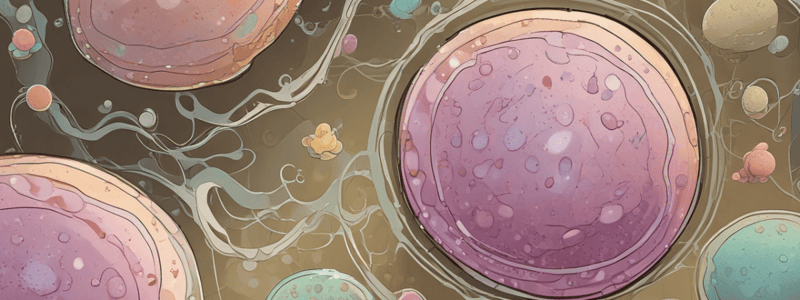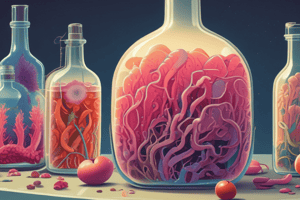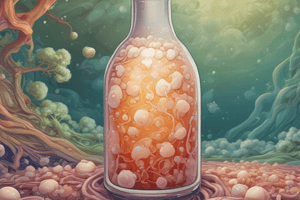Podcast
Questions and Answers
The biological or organic production of ______ dioxide results primarily from yeast fermentation.
The biological or organic production of ______ dioxide results primarily from yeast fermentation.
carbon
Approximately 15 trillion of yeast cells are in one pound of compressed ______.
Approximately 15 trillion of yeast cells are in one pound of compressed ______.
yeast
Fermentation is a process in which yeast cells break down ______ for energy.
Fermentation is a process in which yeast cells break down ______ for energy.
sugars
Visible on the yeast cell in Figure 13.2 are scars from previous ______.
Visible on the yeast cell in Figure 13.2 are scars from previous ______.
Yeast can be thought of as tiny ______ machines, breaking sugars into smaller and simpler molecules with every step.
Yeast can be thought of as tiny ______ machines, breaking sugars into smaller and simpler molecules with every step.
Yeast lacks ______ and cannot break down starch into sugar.
Yeast lacks ______ and cannot break down starch into sugar.
The term ______ is still sometimes used to refer to the many enzymes in yeast that take part in the breakdown of sugars.
The term ______ is still sometimes used to refer to the many enzymes in yeast that take part in the breakdown of sugars.
Fermentation produces as much ______ as it does carbon dioxide.
Fermentation produces as much ______ as it does carbon dioxide.
During fermentation, yeast produces ______ dioxide and alcohol.
During fermentation, yeast produces ______ dioxide and alcohol.
Yeast fermentation is affected by the ______ of dough.
Yeast fermentation is affected by the ______ of dough.
A ______ amount of salt retards yeast fermentation.
A ______ amount of salt retards yeast fermentation.
Small quantities of ______ increase yeast activity.
Small quantities of ______ increase yeast activity.
The optimum pH for yeast fermentation is an acidic range of ______ to 6.
The optimum pH for yeast fermentation is an acidic range of ______ to 6.
Yeast fermentation slows when the pH is above and below ______.
Yeast fermentation slows when the pH is above and below ______.
The presence of ______ agents can slow or stop yeast fermentation.
The presence of ______ agents can slow or stop yeast fermentation.
A large amount of yeast can add an undesirable ______ flavor.
A large amount of yeast can add an undesirable ______ flavor.
Some yeast products sold to bakers contain ______ fermenting yeast.
Some yeast products sold to bakers contain ______ fermenting yeast.
Instant yeast is particularly good for ______ doughs.
Instant yeast is particularly good for ______ doughs.
Some yeast strains grow well in rich doughs, doughs that are high in ______.
Some yeast strains grow well in rich doughs, doughs that are high in ______.
Yeast that grow well in high-sugar environments are sometimes called ______ yeast.
Yeast that grow well in high-sugar environments are sometimes called ______ yeast.
Bread can be made from a traditional, naturally fermented sourdough ______, called levain in French.
Bread can be made from a traditional, naturally fermented sourdough ______, called levain in French.
Starters are prepared by mixing flour and ______ and allowing wild yeast—and lactobacilli bacteria—from the flour and air to ferment the mix.
Starters are prepared by mixing flour and ______ and allowing wild yeast—and lactobacilli bacteria—from the flour and air to ferment the mix.
After a few days to a week of caring and feeding, the ______ is ready to use.
After a few days to a week of caring and feeding, the ______ is ready to use.
A more consistent source of yeast is to use pure ______ cultures.
A more consistent source of yeast is to use pure ______ cultures.
The three main forms of yeast available to the baker today are compressed, active dry, and ______ yeast.
The three main forms of yeast available to the baker today are compressed, active dry, and ______ yeast.
Fresh compressed yeast comes as moist ______ or blocks that are about 30 percent yeast, the rest moisture.
Fresh compressed yeast comes as moist ______ or blocks that are about 30 percent yeast, the rest moisture.
Every pound of active dry yeast contains about one-quarter pound of dead ______ cells.
Every pound of active dry yeast contains about one-quarter pound of dead ______ cells.
While compressed yeast can be crumbled directly into dough, this is not recommended, since it risks uneven distribution of ______ throughout the dough.
While compressed yeast can be crumbled directly into dough, this is not recommended, since it risks uneven distribution of ______ throughout the dough.
Since dead and damaged yeast release a substance—______—that is detrimental to the quality of gluten in dough, active dry yeast is not popular with professional bakers.
Since dead and damaged yeast release a substance—______—that is detrimental to the quality of gluten in dough, active dry yeast is not popular with professional bakers.
Active dry yeast tends to produce slack, sticky doughs and ______ loaves.
Active dry yeast tends to produce slack, sticky doughs and ______ loaves.
If active dry yeast is used, dissolve it in four times its weight in very warm (______–______F; ______–______C) water.
If active dry yeast is used, dissolve it in four times its weight in very warm (______–______F; ______–______C) water.
Instant yeast was developed in the ______s.
Instant yeast was developed in the ______s.
Instant yeast is sold ______ and vacuum-packed.
Instant yeast is sold ______ and vacuum-packed.
Use only one-quarter to one-half ______ yeast for the amount of fresh compressed yeast called for in a formula.
Use only one-quarter to one-half ______ yeast for the amount of fresh compressed yeast called for in a formula.
Instant yeast, if unopened, will last up to one ______ at room temperature without loss in activity.
Instant yeast, if unopened, will last up to one ______ at room temperature without loss in activity.
If it is opened, refrigerate for several months or more, or ______.
If it is opened, refrigerate for several months or more, or ______.
Flashcards are hidden until you start studying
Study Notes
Yeast Fermentation
- Yeast fermentation is a process in which yeast cells break down sugars for energy, producing carbon dioxide and alcohol as byproducts.
- Yeast uses the energy for survival and reproduction.
- The rate of yeast fermentation is affected by several factors, including temperature, amount of salt, amount of sugar, type of sugar, pH of dough, presence of antimicrobial agents, and amount of yeast.
Yeast Cells
- Yeast cells are very small, single-celled microorganisms, with approximately 15 trillion cells in one pound of compressed yeast.
- Yeast cells reproduce by budding, and visible scars from previous buddings can be seen on the yeast cell.
Enzymes and Fermentation
- Yeast can be thought of as tiny enzyme machines, breaking sugars into smaller and simpler molecules with every step.
- Yeast lacks amylase and cannot break down starch into sugar, which is why amylase is an important additive in bread baking.
- The overall process of fermentation involves multiple steps, controlled by separate enzymes, and produces carbon dioxide, alcohol, and small amounts of flavor molecules.
Factors Affecting Yeast Fermentation
- Temperature: Yeast is dormant at 32–34°F (0–1°C), active at 50°F (10°C), and slows down at 120°F (50°C), with an optimal temperature of 78–82°F (25–28°C).
- Amount of salt: Salt retards yeast fermentation, and the optimal amount of salt is 1.8–2.5% (baker's percentage).
- Amount of sugar: Small amounts of sugar (up to 5%) increase yeast activity, while large amounts (above 10%) slow fermentation.
- Type of sugar: Sucrose, glucose, and fructose are fermented rapidly, maltose is fermented slowly, and lactose is not fermented at all.
- pH of dough: The optimal pH for yeast fermentation is an acidic 4 to 6.
- Presence of antimicrobial agents: Certain antimicrobial agents slow or stop yeast fermentation.
- Amount of yeast: The more yeast, the faster the fermentation, but excessive yeast can add an undesirable yeasty flavor and exhaust dough of sugars.
Types of Yeast
- Compressed yeast: Fresh, moist cakes or blocks with 30% yeast and 70% moisture, lasts up to two weeks when stored wrapped in plastic and refrigerated, and three to four months when frozen.
- Active dry yeast: Dried granules with less than 10% moisture, sold in vacuum-packed jars or pouches, and lasts several months at room temperature, longer if frozen or refrigerated.
- Instant yeast: Developed in the 1970s, instant yeast can be added directly to dough without first hydrating in water, and is more vigorous than compressed or active dry yeast.
Sourdough Starters
- Sourdough starters are prepared by mixing flour and water, allowing wild yeast and lactobacilli bacteria to ferment, and can be used to leaven bread.
- Fresh starter does not need to be made for each new day's production, and can be saved for the next day's bread by mixing it with fresh flour and water.
- Some bakeshops pride themselves on the number of years they have continued to bake from their original starter.
Studying That Suits You
Use AI to generate personalized quizzes and flashcards to suit your learning preferences.




